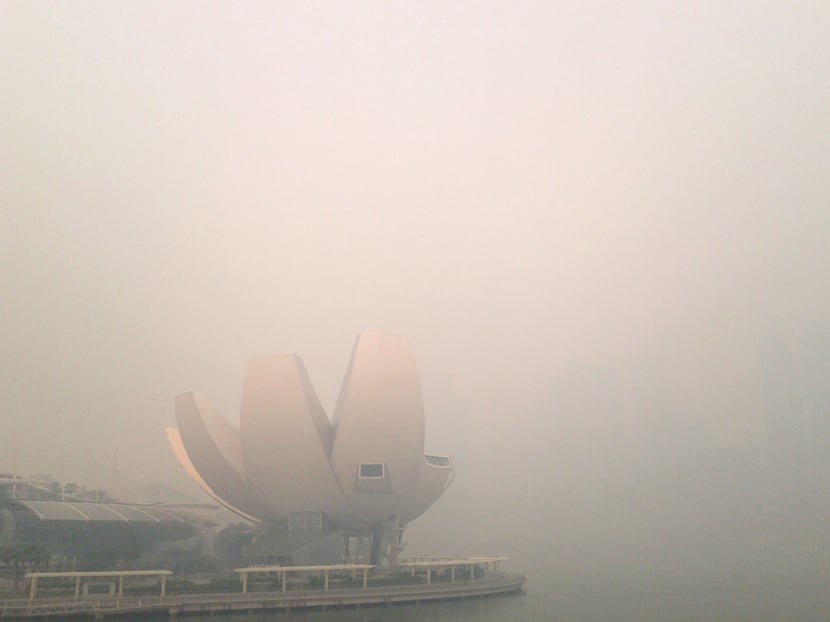‘We can’t wait for the rain or wind to rescue us’
JAKARTA — As the Indonesian government despatches military planes to douse the raging forest fires and investigates plantation companies involved in illegal burning activities, Singapore’s Minister for Environment and Water Resources Vivian Balakrishnan yesterday met his counterpart to discuss the haze problem and hand-deliver a letter by Prime Minister Lee Hsien Loong to President Susilo Bambang Yudhoyono.
JAKARTA — As the Indonesian government despatches military planes to douse the raging forest fires and investigates plantation companies involved in illegal burning activities, Singapore’s Minister for Environment and Water Resources Vivian Balakrishnan yesterday met his counterpart to discuss the haze problem and hand-deliver a letter by Prime Minister Lee Hsien Loong to President Susilo Bambang Yudhoyono.
A statement from Singapore’s Ministry of Foreign Affairs (MFA) said Dr Balakrishnan travelled to Jakarta as Mr Lee’s Special Envoy to personally deliver the letter, in which Mr Lee noted that he and Mr Yudhoyono had agreed to cooperate to combat transboundary pollution at their Leaders’ Retreat in Singapore in April.
The MFA said Mr Lee also “conveyed his grave concern at the impact the severe haze was having on Singapore and Singaporeans and urged Indonesia to take timely and concrete actions to solve the problem”.
Mr Lee offered Singapore’s help to put out the fires in Sumatra, including an aircraft for cloud seeding, as well as satellite pictures and hotspot coordinates to identify the culprits involved in the illegal burning. He also encouraged Indonesia to ratify the Association of South-east Asian Nations Agreement on Transboundary Haze Pollution.
Writing on Facebook, Dr Balakrishnan said he held a “frank constructive meeting” with Indonesian Minister for Environment Balthasar Kambuaya. He said: “I told him that our three-hour PSI had reached 401 today and that millions of Singaporeans, Malaysians and Indonesians were badly affected by the haze. We needed immediate definitive action on the ground. This was a man-made disaster and men had to fix it. We could not wait for the rain or wind to rescue us.”
Dr Balakrishnan said Mr Balthasar told him that Indonesia “appreciated the seriousness of the situation”. He also urged Mr Balthasar to expedite Indonesia’s investigations — which had used satellite maps provided by Singapore — into the errant companies, identify these firms publicly and to prosecute them.
Mr Balthasar agreed to convene the Sub-Regional Ministerial Steering Committee on Transboundary Haze earlier than the original date in August. He also promised to consider Singapore’s offer of assistance and explore how both countries could follow up on the suggestions in Mr Lee’s letter.
Yesterday, Emeritus Senior Minister Goh Chok Tong responded to Indonesia’s Coordinating Minister for People’s Welfare Agung Laksono’s jibe that Singaporeans were “behaving like a child”.
Writing on Facebook, Mr Goh said: “The Singapore Child is being suffocated. How can he not scream?”
He added: “Former Malaysian PM Abdullah Badawi used to say that Malaysians and Singaporeans are like neighbours living in a pair of semi-detached houses. What each does will affect the other. So we have to be considerate in our behaviour like not putting on the TV too loudly or burning our garden refuse openly if the smoke will enter our neighbour’s house.”
Meanwhile, Indonesia’s Forestry Ministry General Secretary Hadi Daryanto told The Jakarta Post on Thursday that Indonesia could not guarantee that necessary measures taken to combat the fires would be effective without a miracle in the form of a heavy downpour. Its meteorological service predicted a downpour next Friday.
“We have considered creating artificial rain to put out the fires, but that would take two weeks. So we’ve decided to leave it in the hands of nature. And let’s just pray for that,” Mr Hadi was quoted as saying. “If there is no downpour, then the haze could last for weeks, or even months, as we try to generate artificial rain.”







